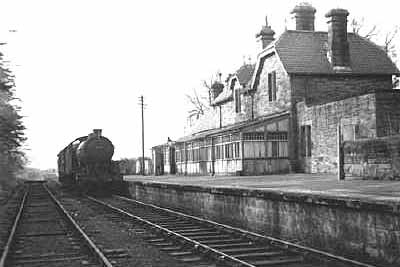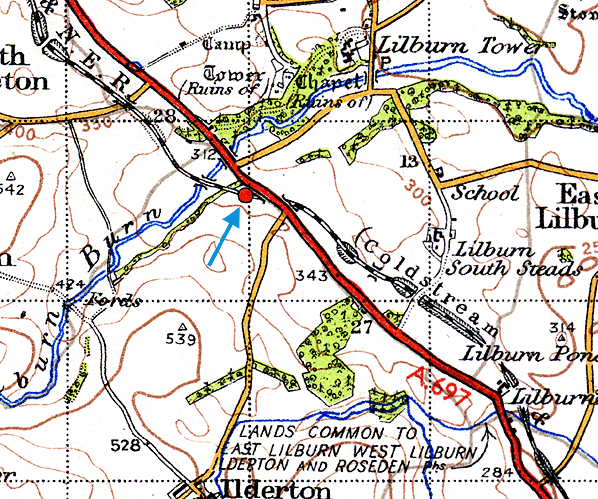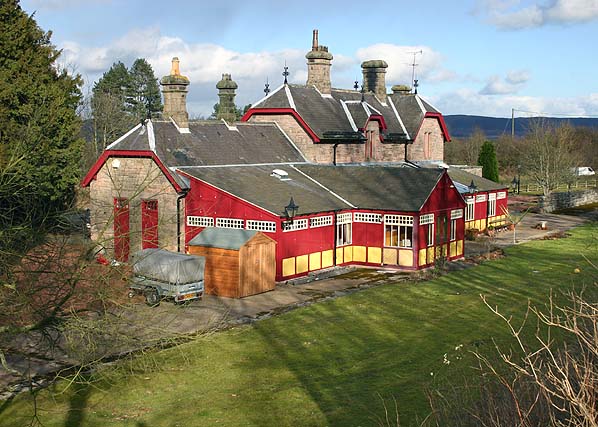|
Notes: Like most of the stations on the Cornhill branch Ilderton station had a long, narrow timber and glass ‘Verandah Room’ and from this access was gained to the Booking Office, First Class waiting room (with lavatory), General waiting room, the Ladies’ waiting room and of course the trains. There was also a Gent’s lavatory and a small Lamp room at the end of the building. Oil lamps provided all the light for the station.
As well as the station house Ilderton had an impressive range of other buildings. In the station yard there was a substantial stone warehouse (complete with loading dock and a one ton crane), a weighbridge and office, livestock loading facilities, coal and lime drops and a signal cabin. Railway staff were housed in two nearby cottages. There were five sidings, one serving the goods shed and three serving an island goods platform with a line wither side of the platform and a line terminating at an end on loading bay at the east end of the platform.
At its peak eight passenger trains per day called at Ilderton, four in each direction. Records show that in 1911 for example, with the local population recorded at 1,252 (including Lilburn and Chillingham), the Booking Office issued 4,279 tickets.
After the railway line at Ilderton closed in 1953 the A697 was realigned through what was once the station yard and a road bridge across the railway was demolished. The station house itself was sold off as a private residence. For many years the building continued to serve the local community, with the new owners running the small post office and shop from the back kitchen of the house. The ‘Verandah Room’ became a garage where vintage cars were kept and restored.
In 1993 work started on converting the station into a restaurant retaining as many of the original railway features as possible. Unfortunately the wooden verandah was beyond repair so a larger wider room was built to replace it. The Station House Restaurant opened on 5th November 1994. The restaurant has now closed and the station has been converted into a private residence.
Additional source: The Story of the Station House - a souvenir booklet produced to mark the opening of the Station House Restaurant. Click here to see the book
BRIEF HISTORY OF THE ALNWICK - CORNHILL BRANCH LINE
In 1881 there was a proposal to build a railway line from Rothbury to Wooler to be called the ‘Central Northumberland Railway’. This plan had the support of the North British Railway who were the North Eastern’s great rivals in Northumberland at the time.
Following local objection from people in Alnwick who didn't want to see agricultural traffic from the Wooler area being diverted to the market town of Rothbury Alnwick traders, politicians and local land owners combined to put pressure on the North Eastern Railway to come up with a counter proposal. The N.E.R. proposed the ‘Cornhill Branch’running from their existing station at Alnwick through Wooler to a junction with the Tweedmouth to Kelso lined at Cornhill on Tweed.
Both proposals went before Parliament in 1881 but the Cornhill branch was by far the cheapest and an act was passed authorising the North Eastern Railway to build their 36 mile line from Alnwick to Cornhill; construction commenced the following year.
Alnwick station was lavishly rebuilt and to avoid the Duke of Northumberland's estate north of Alnwick, the line initially headed south with the expensive diversion requiring a tunnel and a viaduct at Edlingham.
After some delays the line finally opened to good and mineral traffic between Coldstream and Wooperton 2nd May 1887 and throughout for all traffic on 5th September 1887. The line was single track throughout with passing loops at all stations; only Wooler Station had a second platform and Whittingham and island platform. Initially the line was well used but this was short lived and passenger services fell into decline after WW1 as the line was unable to compete with the new and more convenient bus services. Staffing levels were reduced, signal boxes closed and station masters were put in charge of more than one station but the line continued to lose money and an early decision was taken by the London & North Eastern Railway to withdraw passenger services. The final passenger train ran between Alnwick and Cornhill on 22nd September 1930, only 43 years after the line had opened
 |
Despite losing its passenger trains the line remained open for freight mainly for local farmers, with regular goods trains. As a sideline the railway rented out disused waiting rooms and old carriages as self-catering holiday homes. These were known as ‘Camping Coaches’ and Cottages and they were a popular tourist attraction on this and many other lines from the thirties until the early sixties |
During the Second World War the branch enjoyed a brief revival when Akeld station became the railhead for a new R.A.F. airfield at Milfield. After the war the airfield’s giant hangers were used for grain storage, and traffic to an from these helped keep the line open but the line's days were numbered.
The line suffered serious storm damage between Ilderton and Wooler in August 1948 with further storm damage the following year when as bridge north of Ilderton station was washed away. With such meagre traffic on the branch the newly formed British Railways could not justify the cost of replacing the bridge; instead the line became two lines; one from Alnwick to Ilderton, and the other from Coldstream to Wooler bur the service was infrequent, sometimes only one train a week.
The section from Alnwick to Ilderton eventually closed on 2nd March 1953. The Coldstream (Cornhill) to Wooler stretch survived a while longer before falling victim to the notorious Dr. Beeching’s railway cuts. It finally closed in March 1965, along with the Tweedmouth to Kelso line. Railway enthusiasts ran a special passenger train into Wooler shortly before the closure.
Other web sites:
Northumbrian Railways - The Cornhill Branch. Tickets from Michael Stewart
To see other stations on the Alnwick - Cornhill (Coldstream) line click on the station name: Alnwick, Edlingham, Whittingham, Glanton, Hedgeley, Wooperton, Wooler, Akeld, Kirknewton, Mindrum & Coldstream.
|

old4.jpg)

11.jpg)

 Home Page
Home Page 














